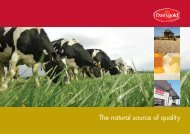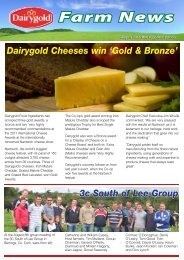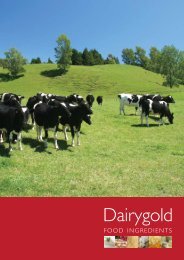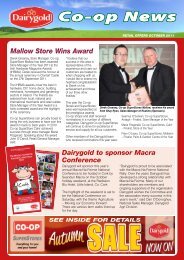Annual Report 2009 - Dairygold
Annual Report 2009 - Dairygold
Annual Report 2009 - Dairygold
You also want an ePaper? Increase the reach of your titles
YUMPU automatically turns print PDFs into web optimized ePapers that Google loves.
<strong>Dairygold</strong> Co-Operative Society Limited <strong>Annual</strong> <strong>Report</strong> and Accounts <strong>2009</strong><br />
Statement of Accounting Policies<br />
The significant accounting policies adopted by the Society are:<br />
Basis of Preparation:<br />
The financial statements have been<br />
prepared in accordance with generally<br />
accepted accounting standards in Ireland<br />
and the Irish Industrial and Provident<br />
Societies Acts, 1893 to 1978.<br />
Accounting Convention:<br />
The financial statements, which are<br />
denominated in euros, are prepared<br />
under the historical cost convention as<br />
modified by the revaluation of certain<br />
fixed assets.<br />
Basis of Consolidation:<br />
The consolidated financial statements<br />
incorporate:<br />
a) the accounts of <strong>Dairygold</strong> Co-<br />
Operative Society Limited (“the<br />
Society”) and its subsidiaries for the<br />
year to 31 December <strong>2009</strong>,<br />
b) the Society’s share of the results<br />
and post acquisition reserves of<br />
associates as reported in the latest<br />
audited financial statements. This is<br />
to 30 June <strong>2009</strong> for Reox Holdings plc<br />
and 31 October <strong>2009</strong> for The Malting<br />
Company of Ireland. Other associates<br />
results are included to 31 December<br />
2008.<br />
c) any material adjustments for<br />
associates arising between the date<br />
of their latest financial statements as<br />
above and the year end of the Society<br />
and consequently Reox Holdings<br />
plc results are incorporated to 31<br />
December <strong>2009</strong>.<br />
The results of subsidiaries acquired or<br />
disposed of are included in or excluded<br />
from the financial statements from the<br />
effective date of acquisition or disposal.<br />
The interests of minority shareholders<br />
in subsidiary companies reflect the<br />
minority’s proportion of the net assets of<br />
the relevant subsidiaries.<br />
The results of overseas subsidiary<br />
companies are translated into euros at<br />
the average rate for the year. The assets<br />
and liabilities of overseas subsidiary<br />
companies have been consolidated at the<br />
rate of exchange ruling on the balance<br />
sheet date. Surpluses or deficits arising<br />
on the translation of overseas subsidiary<br />
companies’ net assets are included in<br />
reserves.<br />
Turnover:<br />
Turnover represents the invoiced value<br />
of goods and services to third parties,<br />
including EU export refunds and<br />
excluding value added tax. Turnover is<br />
recognised when the Society receives<br />
the right to consideration as ownership<br />
passes to third parties.<br />
Share Trading:<br />
Accounting for Transactions<br />
Investment transactions are accounted<br />
for on the trade date. All investments are<br />
stated at cost and are not subsequently<br />
revalued. Realised gains and losses on<br />
investment disposals are calculated<br />
using the first in first out method based<br />
on the difference between the original<br />
cost and the disposal amount.<br />
A provision is made for impairment in<br />
value particularly in the case where<br />
impairment is permanent as evidenced<br />
by losses crystallised post year end.<br />
Investment Income and Expenses<br />
Dividends are recognised as income on<br />
the dates that securities are first quoted<br />
“ex-dividend” to the extent information<br />
thereon is reasonably available to the<br />
Society. Interest income is recognised by<br />
the Society on an accruals basis. Income<br />
from quoted companies is stated gross<br />
of withholding tax, which is disclosed<br />
separately in the profit and loss account.<br />
Tangible Fixed Assets and<br />
Depreciation:<br />
Tangible fixed assets are stated at cost or<br />
valuation less accumulated depreciation.<br />
Depreciation is calculated to write off<br />
the cost or valuation of tangible fixed<br />
assets other than freehold land over their<br />
estimated useful lives by equal annual<br />
instalments at the following annual<br />
rates:<br />
Buildings<br />
2.0% - 10.0%<br />
Plant and machinery<br />
7.5% - 33.3%<br />
Motor vehicles<br />
20.0% - 25.0%<br />
The carrying value of tangible assets<br />
is reviewed for impairment if events or<br />
changes in circumstances indicate the<br />
carrying value may not be recoverable.<br />
Impairment is assessed by comparing<br />
the carrying value of an asset with its<br />
recoverable amount (being the higher<br />
of net realisable value and value in<br />
use). Net realisable value is defined<br />
as the amount at which an asset could<br />
be disposed of net of any direct selling<br />
costs. Value in use is defined as the<br />
present value of the future cash flows<br />
obtainable through continued use of an<br />
asset including those to be realised on its<br />
eventual disposal.<br />
Leased Assets:<br />
Assets held under leasing arrangements<br />
that transfer substantially all the<br />
risks and rewards of ownership are<br />
capitalised. The capital element of the<br />
related rental obligations is included in<br />
creditors. The interest element of the<br />
rental obligations is charged to the profit<br />
and loss account so as to produce a<br />
constant periodic rate of charge. Rentals<br />
in respect of all other leases are charged<br />
to the profit and loss account as incurred.<br />
Goodwill:<br />
Goodwill arising on acquisitions<br />
representing the excess of the total cost<br />
of the Society’s investment over the<br />
fair value of the separable net assets<br />
acquired is amortised over its expected<br />
useful economic life of twenty years, on<br />
a straight line basis. The carrying value<br />
of goodwill is reviewed annually and<br />
provision is made for any impairment.<br />
Intangible Assets:<br />
Purchased intangible assets are included<br />
at cost and amortised in equal annual<br />
instalments over a period of twenty<br />
years which is their estimated useful<br />
economic life. A provision is made for<br />
any impairment in value.<br />
30







